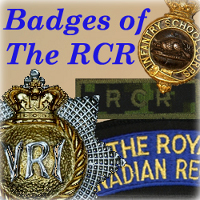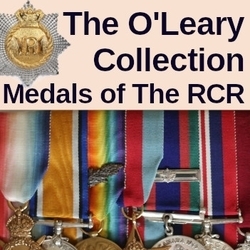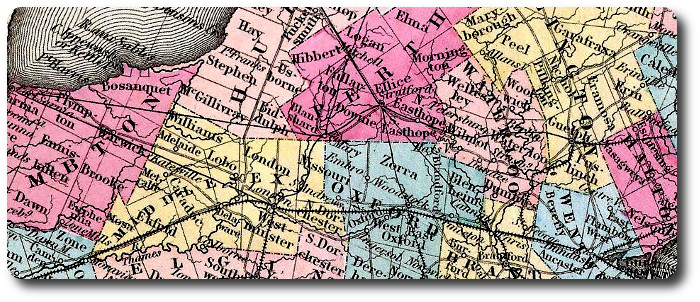
Researching The Royal Canadian Regiment
Heritage but not Necessarily Lineage;
The RCR and Historic South-Western Ontario Units
By: Michael M. O'Leary
In 2012, the Canadian Government decided to award honours for the War of 1812. Units of the Canadian Militia were identified as the recipient units for these honours in a plan that varied between discussions of Honorary Distinctions and the awarding of formal Battle Honours. This led to the award of the right to perpetuate the Battle Honour "DETROIT" to The Royal Canadian Regiment in August 2012. This battle honour, granted to the 1st Regiment of Middlesex Militia (1812-1815) and the 1st Regiment of Oxford Militia (1812-1815), is perpetuated by The RCR on the basis of the fact that the 4th Battalion still recruits in the same communities and counties as those War of 1812 Militia units.
Those two regiments along with other War of 1812 units, have the benefit of attention received because of their brief existence during a time of conflict. What other units, both pre and post-Confederation, would be entitled to at least a similar heritage recognition due to the localities within which they were raised? It is an unfortunate trend that historians, both professional and amateur, tend to focus on the high points in history; wars, disasters and other critical events. With regard to military history, that often means that the roles played by those who serve in time of peace, or who serve during those times of crisis, but outside the area of conflict or other operations, tend to be overlooked or marginalized.
This connection of geography, and the newly created perpetuation of pre-Confederation militia units through coincident localization to modern units, raises an interesting question. What other long-gone units within a modern regiment's, or battalion's, current area of recruitment are also deserving of being remembered, even if only in a list of names and places to remind us of the length and breadth of our military heritage among the citizens of our nation?
It is the purpose of these few pages to explore that question with regard to the 4th Battalion of The Royal Canadian Regiment. The Regiment, as a whole, receives recruits from across the nation for the three Regular Force Battalions, but the 4th Battalion, as a Reserve unit, continues to recruit in the counties where it has an established lineage dating back to the 1860s. Which units, therefore, are the local forerunners of 4RCR on this geographic basis?
The Fine Line Between Lineage and Heritage
In many towns and cities in Southwestern Ontario, a diligent observer can find old traces of military presence, both British led and locally raised. These traces can most often be found in local museums, older churches and on the occasional heritage site plaque. The details of much of this history is forgotten to the average Canadian, and even to many soldiers who claim familiarity with their regimental histories, the understanding of local heritage and/or regimental lineage connections to the earlier military presence can be murky.
While some units of past eras remain well entrenched in the official lineages of existing regiments of the Canadian Army, others are nearly forgotten, commemorated, if at all, on those memorial plaques in old churches and their history; what little remains preserved by local museums and volunteer historians. All too often so little trace remains that we are surprised to discover that some crossroad with an old general store was once a thriving village and that a company of infantry was raised in its vicinity. The Sedentary Militia could be found almost everywhere the country had settlements. While many Regiments can trace their lineage back to the raising of units in the 1860s or later, those regiments also have a separate but often much deeper local heritage based on those scattered independent companies of Sedentary Militia. While some care is needed to effectively describe the separation between lineage and heritage while giving both due recognition, those heritage roots of local Militia (now Reserve) units runs deep in each of Canada's provinces.
The War of 1812 Battle Honours
Click image to see full map.

The War of 1812 units which The RCR will perpetuate.
In 2012, the Canadian Government decided to create heritage links to the Militia units of the War of 1812. Many of these units existed only for the duration of that conflict and they had no direct connections to the local units that followed them. With no unbroken lineage to the existing Canadian Militia, or to any units formed after the 1855 Militia Act, there was no direct links based on the evolution of Militia and Reserve units in Canada to award rights of perpetuation under existing practices. In the absence of established procedures for such recognition, and in order to meet the Government's desire to establish heritage links, discussions initially proposed creating a new Honorary Distinction, and the selection of perpetuating units would be based on coincident geography with the War of 1812 Militia units. Therefore, units of the Canadian Army were offered the privilege of perpetuating War of 1812 units if they remained in or were connected to the towns or counties in which the War of 1812 Militia units were raised. As it happened, by the time the Government's plan was executed, some of these became Battle Honours awarded to War of 1812 units which would then be perpetuated by modern units of the Canadian Army.
For The Royal Canadian Regiment, this offer of perpetuation was based on the recruiting area of the Regiment's 4th Battalion, and resulted in the following War of 1812 units being identified:
- The Loyal London Volunteers;
- 1st Regiment of Middlesex Militia; and
- 1st Regiment of Oxford Militia.
Heritage Connections Based on Geography
The establishment of links to long extinct units solely on a basis of geographical coincidence with the 4th Battalion, The Royal Canadian Regiment, raises an intriguing question. While the underlying cause for the identification of those three units of the War of 1812 was the bicentennial of the war that caused their creation, what other units could also be acknowledged because they had overlapping areas of recruitment with the Reserve battalion of The RCR.
The 2012 initiative by the Canadian Government to link existing Army units to War of 1812 units based solely on coincidences of geography raised an interesting question:
- Should not other units raised in the same geographical area also be considered for acknowledgement of community (or county) based military heritage, even if that acknowledgement is only to recognize that they existed in our current recruiting territories?
As in so many things, the devil remains in the details. In this case, those details require identifying the "catchment" area for a given regiment, discovering the units raised in that area, and also confirming of any of those units already have established connections to other regiment.
Defining the 4RCR Geographical Area
Click image to enlarge.
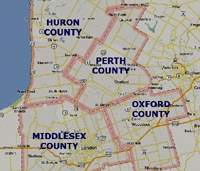
The four counties comprising 4RCR's principal recruiting area. (Map image based on Google Maps source images.)
In order to answer that question, it was first necessary to determine what area would be considered applicable to the 4th Battalion. To accomplish this, nominal rolls for 4RCR (dated 2009 and 2012) were examined and the lists of hometown distilled from them. Plotting these locations showed an expected density of locations around London and Stratford, the current garrisons for the battalion, but also a large number of outliers. Most of these locations, once plotted on a map, formed a central distinctly identifiable region while others were spread further afield. We can set aside the more broadly spread outliers as the home addresses of unit members who were attending university in London.
The plotted locations which remain fall within four identifiable Ontario counties: Middlesex, Oxford, Huron and Perth. This region of four counties, therefore, can be taken as the principal catchment area for 4RCR's recruiting and will be used as the basis for the following analysis.
This map shows the hometown locations identified in two 4RCR nominal rolls (dated 2009 and 2012).
Units of the Canadian Militia within the 4RCR Catchment Area
Click image to see full map.
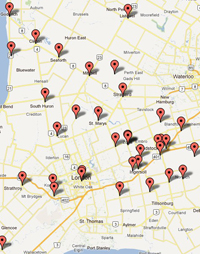
Units of the Pre and Post-Confederation Militia which were raised in the current 4RCR recruiting area.
The campaign to recognize units of the War of 1812 focused solely on the units raised for that conflict. The Canadian Government's response, however, while acknowledging a willingness to recognize those units raised in the Colonies which would later become Canada, also confirmed that the only connection to the existing Canadian Army was through the coincidence of geography. Current units existing in, or traditionally recruiting from, the same communities and counties that raised the War of 1812 units were offered the choice to recognize perpetuation through an Honorary Distinction.
This approach taken by the Canadian Government opens the door to considering that the same type of connection, though without formal designation, exists to any former unit of the Canadian Militia within an existing unit's recruiting catchment area. While units can easily identify the regiments within their direct lineage, and the Government has now confirmed the applicable, War of 1812 units, it remains to confirm what other units of the Militia, both pre and post-Confederation, also existed within a given recruiting area.
A surprising number of Militia units were raised within the four counties of Middlesex, Oxford, Huron and Perth. Some lasted decades, others for shorter periods. Some have survived to be represented in the official lineage of The Royal Canadian Regiment, while others have had no existing unit representing them since their disbandment. Acknowledging common geography, and therefore the common demographic recruiting base, neither takes away from these units' proud heritage nor forms an attempt to claim it. Identifying these units on a geographical basis does serve to form a basis on which future connections may be established and maintained through education of today's soldiers with a better understanding of our regional forebears.
This map shows the Canadian Militia units which were raised within the current 4RCR catchment area. If you are aware of any that I have been missed, I would appreciate receiving a note and a reference by e-mail.
CEF Infantry Battalions raised within the 4RCR Catchment Area
Click image to see full map.
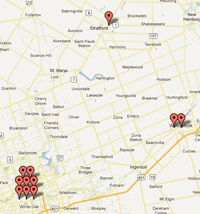
Infantry battalions of the CEF which were raised, in whole or in part, in the current 4RCR recruiting area.
Identifying the Militia units within the 4RCR catchment area still leaves one group of units unexamined. While six units of the Canadian Expeditionary Force are currently perpetuated by The RCR, and five of those were infantry battalions raised in Canada, they do provide not a complete accounting of units raised within the geographical boundaries under discussion.
In the interests of completeness, each of the infantry battalions raised, in whole or in part, within the four county area should be identified, and where existing formal perpetuation exists, it should be recognized that those units are already represented by existing units.
This map shows the CEF infantry battalions which were raised, in whole or in part, within the current 4RCR catchment area.
Representation by Existing Units other than The RCR
While the preceding discussion and linked pages cover infantry units raised in the counties of Middlesex, Oxford, Huron and Perth, it must be kept in mind that some are still perpetuated by units other than The Royal Canadian Regiment. The Perth Regiment, though currently held at "Nil" strength, remains on the Canadian Army's order of battle. As a result of the Perth Regiment's continuing status as an existing, although not active, regiment, that regiment's perpetuation of the 110th Canadian Infantry Battalion, CEF, needs also to be acknowledged. Similarly, the 18th Canadian Infantry Battalion is perpetuated by the Essex and Kent Scottish Regiment and the 259th Canadian Infantry Battalion (CSEF) is perpetuated by the 12e Régiment blindé du Canada. The latter perpetuation was effected on 25 Jun 1998 after the CF Directorate of History and Heritage sought units to continue the perpetuation of the 259th and 260th Battalions of the Canadian Siberian Expeditionary Force. (This perpetuation had been offered to The Royal Canadian Regiment, but refused because the link of London, Ontario, being one of four recruiting centres for the unit was determined to be too slight a connection.)
Pro Patria
- The O'Leary Collection; Medals of The Royal Canadian Regiment.
- Researching Canadian Soldiers of the First World War
- Researching The Royal Canadian Regiment
- The RCR in the First World War
- Badges of The RCR
- The Senior Subaltern
- The Minute Book (blog)
- Rogue Papers
- Tactical Primers
- The Regimental Library
- Battle Honours
- Perpetuation of the CEF
- A Miscellany
- Quotes
- The Frontenac Times
- Site Map
QUICK LINKS
![]() Too Few Honours; Rumours of Historical Parsimony in Regimental Honours and Awards
Too Few Honours; Rumours of Historical Parsimony in Regimental Honours and Awards
![]() The RCR and Historic South-Western Ontario Units
The RCR and Historic South-Western Ontario Units

